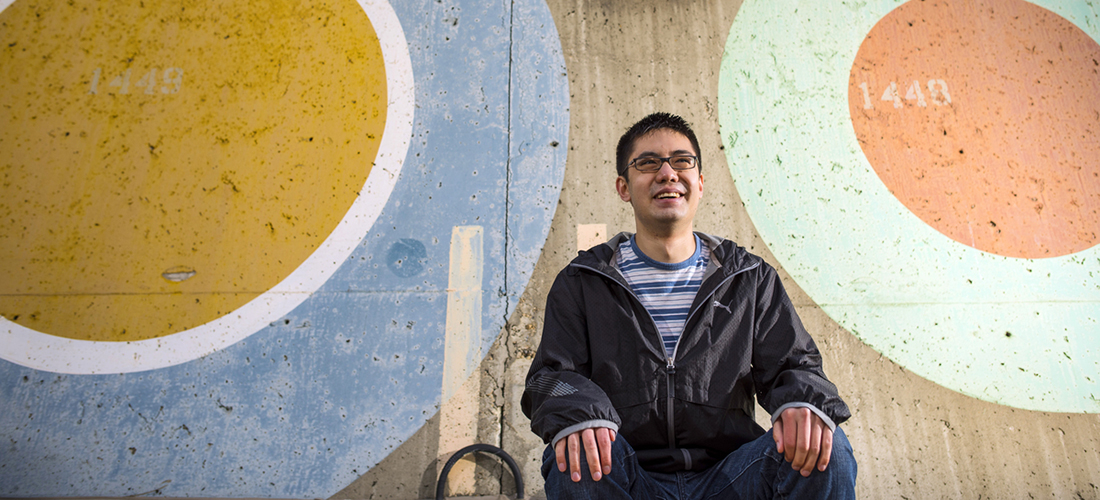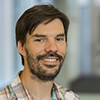
"I used to think all math was just calculus-and I liked calculus, so that wasn't a bad thing-but there was all this other stuff, like graph theory, number theory-all these brand new fields I didn't know even existed."-Ryan Morrill
Outdating written records, the study of mathematics may be the oldest of these pillars-piquing human curiosity for longer than we've been keeping track. Given this, it is unsurprising that the etymological root of the word mathematics stems simply from the ancient Greek word for "learning."
Often called a "pure" science, mathematics in its most basic form often emphasizes the idea of doing math for math's sake, regardless of whether a practical application is apparent at the outset. While applications are often found after the fact-for example, number theory as applied to cryptography in computer science-this notion of basic research holds a sacred appeal for those attracted to the idea of problem-solving without the pressure to produce marketable results.
All for math...
After two years studying at MacEwan University, Edmonton-born Ryan Morrill ('14 BSc) transferred to the University of Alberta, where he was introduced to a different side of math in MATH 222 (Discrete Math). "This course was just pure problem solving, pure logic. It was really different from anything I'd ever taken before," he explains, describing how the instructor would often sit in front of the class and present a problem, then ask the students simply to think about it. "It was a very organic approach to problem solving."
"I used to think all math was just calculus-and I liked calculus, so that wasn't a bad thing-but there was all this other stuff, like graph theory, number theory-all these brand new fields I didn't know even existed." -Ryan Morrill
The experience was illuminating. Like many undergraduate science students, Morrill began his education with aspirations of pursuing a career in medicine, but the experience he had in MATH 222 stuck with him. He switched from general science to a math major, and is now pursuing a master's degree in the area.
"I feel like people often just think of the U of A as a research institution, not an educational institution," he says. "But there are a lot of really good instructors here-definitely in math. That's something that made me really glad that I picked the U of A."
...and math for all
 At the completion of that first math class, Morrill was offered an opportunity to pick up the torch and help lead a math circle over the summer, training a group of junior high students for an international competition. The group met for a few hours almost every day, with the top eight students joining Morrill for the competition in Taiwan at the end of the summer.
At the completion of that first math class, Morrill was offered an opportunity to pick up the torch and help lead a math circle over the summer, training a group of junior high students for an international competition. The group met for a few hours almost every day, with the top eight students joining Morrill for the competition in Taiwan at the end of the summer.
Morrill has since taken over the JAMES math circle (Junior Alberta Mathematics for Eager Students) year-round. "A math circle has a lot more structure than a math club," he explains. "Each session has a distinct purpose to teach a certain concept. It might be an introduction to a field of math-so maybe we'll have a session on graph theory, or maybe it'll be a session on a problem solving strategy."
The circle now meets once a week, and while the majority of students attend regularly, Morrill makes a point to design each session to stand firmly on its own. "I usually try to make sure that the sessions we do don't relate too heavily to each other, so if somebody misses a lecture, I don't want them to feel too far behind, or if someone drops in for the first time they don't feel lost."
"I hope that when they leave the circle, they become better critical thinkers." -Ryan Morrill
Though the circle is targeted specifically to strong math students looking for a challenge, Morrill also strives to imbue his students with skills that will help beyond their studies. "I hope that they can take the things they've slowly been learning over the years and become better learners as a result of that. I think that's really the most important thing-to become a better learner.
"I hope that when they leave the circle, they become better critical thinkers. I'm not actually too concerned that they take away concrete math knowledge. I want to focus more on problem solving abilities and learning things that will help them in whatever they go on to do."
As an educator, Morrill gets as much out of the math circle as his students do. He sees the circle as an opportunity for him to improve his own teaching abilities, since the flexible format allows him to experiment with fresh approaches to teaching. "I was just looking for a job, really anything-and I ended up getting all this stuff to do with education and students. Once I did that for a bit, I found I really enjoyed it, so I kept doing it."
So much in fact, that he is considering continuing on in a PhD not to pursue research, but to teach at the postsecondary level.
He is well on his way to success in that area as well, having been honoured with a Graduate Student Teaching Award this spring. And Morrill is in good company-the U of A's Department of Mathematical and Statistical Sciences is stacked with award-winning instructors.

 One of them, the 2016 winner of the Faculty of Science Award for Excellent Teaching is Sean Graves ('01 BEd, '07 MSc), another educator who simply couldn't resist his calling. After obtaining his education degree from the U of A, Graves taught in England and Japan for several years before returning to Canada to obtain his master's degree in-you guessed it-mathematics. "Upon returning to Canada, I had reflected on how much I enjoyed the last few mathematics courses that I completed during my education degree, which led to my decision to study more math," says Graves.
One of them, the 2016 winner of the Faculty of Science Award for Excellent Teaching is Sean Graves ('01 BEd, '07 MSc), another educator who simply couldn't resist his calling. After obtaining his education degree from the U of A, Graves taught in England and Japan for several years before returning to Canada to obtain his master's degree in-you guessed it-mathematics. "Upon returning to Canada, I had reflected on how much I enjoyed the last few mathematics courses that I completed during my education degree, which led to my decision to study more math," says Graves.
He has now been teaching at the U of A for nine years, the past four of which he has spent additionally coordinating the Decima Robinson Support Centre for Mathematical and Statistical Sciences.
"My ultimate objective is to provide others an opportunity to witness the beauty and the satisfaction that I see when studying mathematics" -Sean Graves
A testament to math's deep connection to almost every academic discipline, the centre is fittingly named after first ever graduate of the University of Alberta, Decima Robinson ('11 BSc, '12 MSc)-a mathematics major called the "Calculus Maid" by her classmates.
More than a century after her graduation, Robinson's legacy lives on in the centre bearing her name. The resource is available to all undergraduate students enrolled in a 100- or 200-level MATH or STAT course, and is accessed by thousands of students every month. A team of up to six volunteer graduate and senior undergraduate students are available throughout the day to help walk students through challenging problems.
"My ultimate objective is to provide others an opportunity to witness the beauty and the satisfaction that I see when studying mathematics," says Graves. "I hope my passion for mathematics shines through when I teach my students and that I can inspire some of them to further their own studies in this glorious subject."
In addition to offering day-to-day student support, the centre is also home to the JAMES Math Circle and the Alberta Summer Mathematics Institute, a summer-long day camp for strong high school students to learn advanced mathematics and explore directed research.

Sharing the love
 Student support in mathematics extends far beyond campus borders. Faculty of Science award winner for Innovation in Teaching Vincent Bouchard has been involved for the past several years in a two-week-long math summer camp at the Maskwacis Cree Reserve-specifically with the Ermineskin Cree Nation-located about an hour south of Edmonton.
Student support in mathematics extends far beyond campus borders. Faculty of Science award winner for Innovation in Teaching Vincent Bouchard has been involved for the past several years in a two-week-long math summer camp at the Maskwacis Cree Reserve-specifically with the Ermineskin Cree Nation-located about an hour south of Edmonton.
"Ermineskin is a really interesting place to work. While they have had trouble with school success rates as have many other First Nations, Ermineskin has a very well established and stable school system and is actively developing new initiatives to improve education," says Bouchard. "The math camp is part of this push. In many respects, I think that they are an educational model for many other First Nations."
The camp is designed for students in grades five to eight, with a goal to improve and expand basic math skills. The camp includes a one-day trip to the University of Alberta campus-a highlight for many of the campers. "It is quite inspiring to see how excited and enthusiastic the kids are about the U of A campus," says Bouchard. "Each year, many of them tell me that they would really like to come here one day."
"Mathematics is more like an art. It can be hard to explain what we do."-Vincent Bouchard
The camp has been a massive success, nearly doubling its enrolment in its first three years. Math is all about numbers, so the significance is not lost on anyone that 71 per cent of students showed measurable improvement in math skills after attending the camp. Additionally, in the 2016 Canada-wide Mathletics Challenge, Ermineskin Elementary school placed 34th out of 635 participating schools across Canada.
Despite its reputation for difficulty-or maybe as a direct result of it-the study of mathematics holds an undeniable attraction for those in its thrall. "Mathematicians are not often understood," reflects Bouchard. "Mathematics is more like an art. It can be hard to explain what we do."
Perhaps it is the challenge of teaching an intimidating topic, or simply the intrinsic appeal of pure, curiosity-driven research-the simplicity of approaching a problem stripped down to its most basic parts-that compels so many of these artists to share their passion with others.
Whatever the reason, there is no question that it is a love worth sharing-and sharing broadly.